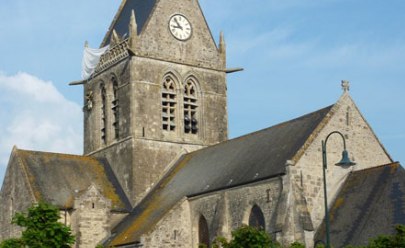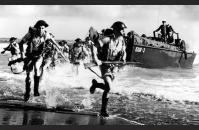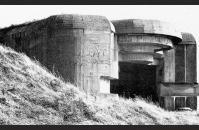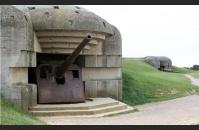TOURING NORMANDY AT A GLANCE:

Image Gallery
Touring Normandy
With three hundred seventy-five miles of beaches, cliffs, farming villages and ports, Normandy is a contrasting landscape of ancient fortresses and castles, ruined monasteries, and rolling farmland replete with memories of World War II and scarred with evidence of the Allied D-Day invasion of June 6, 1944. While there are many faces of Normandy, this fact sheet provides some basic suggestions for those travelers wishing to visit D-Day-related sites.
Top Sites (traveling east to west):
Pegasus Bridge. Located on the Caen Canal, this key bridge was captured by British airborne troops in the early morning hours of D-Day, helping to secure the eastern flank of the invasion. Although the original bridge was taken down in 1994, a museum marks the site of this crucial coup de main operation.
“The Memorial and Museum of Peace.” Caen’s Battle of Normandy Museum offers guided tours of the landing beaches (British and American) along with a pass to the memorial. Caen is the site of the British breakout through German lines.
WWII Museum at Bayeux. While this town’s chief attraction is its 11th century tapestry honoring William the Conqueror’s victory at Hastings in 1066, the Musée Mémorial de la Bataille de Normandie 1944 paints a vivid picture of the Allied invasion and campaign in Normandy.
Arromanches. See the remnants of Mulberry B, one of two huge artificial harbors the Allies towed to Normandy from England. The Museum here has a great model, showing how the structure worked.
Omaha Beach. One of two beaches attacked by American forces on D-Day (the other is Utah Beach). Located near the town of St. Laurent, Omaha Beach was the bloodiest of the D-Day beaches. You can still see remnants of one of the Mulberries, or artificial harbors, the Allies built to support the invasion.
American Military Cemetery at St. Laurent. Stretching across the bluff overlooking Omaha Beach, the rows of white marble crosses and stars commemorate the men who died fighting for the Allied victory in Normandy. A must see.
Pointe-du-Hoc. The elite U.S. Rangers scaled this 40-meter high cliff between Omaha and Utah beaches to neutralize a dangerous German gun battery. Check out the cliffs, the ruins of German bunkers, the bomb craters, and see if they were successful.
St.-Lô. In the town where the Americans finally broke through the German lines, the Holy Cross Church is home to a memorial to Major Thomas Howie, who had vowed to be the first American in St.-Lô. He was killed shortly before his troops took the city.
Utah Beach. The area around Utah Beach contains monuments, abandoned tanks, and pillboxes—reminders of D-Day. The Musée du Débarquement, near La Madeleine, is located in a German bunker, and offers striking accounts of the battle for Normandy.
Ste-Mère-Eglise. In this town which was taken by the US Airborne on D-Day, the Musée des Troupes Aéroportées includes photos, a glider, and parachutes commemorating the morning of June 6, 1944 when American paratroopers dropped over the town to secure the western flank of the invasion.
Recommended Travel Books:
Holt, Tonie and Valmai. The Visitor’s Guide to Normandy Landing Beaches.
Williams, Nia. AAA Essential Normandy: All You Need to Know.
Braunger, Manfred. Insight Compact Guide: Normandy.
Shilleto, Carl and Mike Tolhurst.A Traveler’s Guide to D-Day and the Battle for Normandy.
Download a printable version of this At A Glance
TAKE ACTION:


EDUCATION PROJECTS:
Student Travel – WWII Educational Tours
High school and college students, learn the leadership principles that helped win WWII on a trip to France or during a weeklong residential program in New Orleans. College credit is available, and space is limited.
See You Next Year! HS Yearbooks from WWII
Collected from across the United States, the words and pictures of these yearbooks present a new opportunity to experience the many challenges, setbacks and triumphs of the war through the eyes of America’s youth.
The Victory Gardens of WWII
Visit the Classroom Victory Garden Project website to learn about food production during WWII, find lesson plans and activities for elementary students, get tips for starting your own garden and try out simple Victory Garden recipes!
The Science and Technology of WWII
Visit our new interactive website to learn about wartime technical and scientific advances that forever changed our world. Incorporates STEM principles to use in the classroom.
Kids Corner: Fun and Games!
Make your own propaganda posters, test your memory, solve puzzles and more! Learn about World War II and have fun at the same time.






